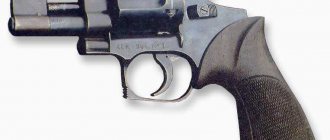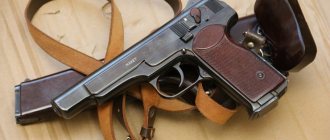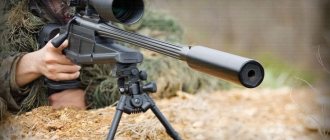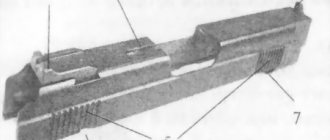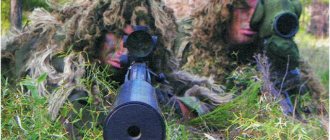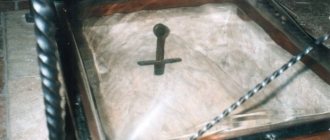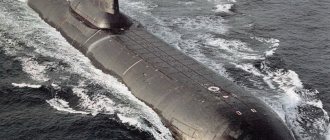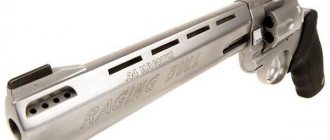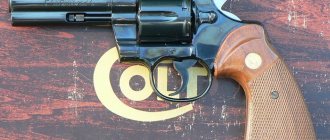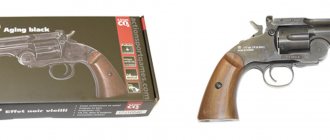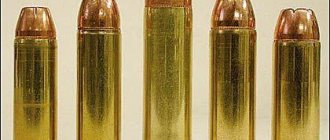Colt's idea of creating a revolver was prompted by observations of a rotating mechanism on the ship Corvo, on which he traveled from Boston to Calcutta. On board the Corvo, he made a model out of wood; upon returning to the United States, Colt applied to the patent office and issued patent No. 1304 dated August 29 (according to other sources, February 25), 1836, describing the basic principle of operation of a weapon with a rotating drum.
all4shooters.com / all4hunters.com - international website for sports shooters and hunters
BE A SHOOTER!
Guns, ammo, optics and passion: these are the four key elements that unite gun enthusiasts around the world. all4shooters.com is an international platform that will be your window to this world - in four languages.
The motto of all4shooters.com and all4hunters.com is simple:
We exist for all those who have a passion for hunting and shooting, both as a shooting sport and as a hobby - or for those who are simply lovers of weapons, optics and accessories. At all4hunters.com we focus on hunting weapons, hunting ammunition and related optics and equipment. We also provide the latest news from around the world, as well as everything you need to know about new products and events related to your specific hobby. We provide important information about each relevant market - in four different languages. Our deep understanding of each individual market is where our strength lies—along with our ability to deliver information worldwide via the Internet.
all4shooters.com / all4hunters.com is a fun, comprehensive, informative and at the same time explanatory website. Our core philosophy is to report in a balanced, impartial and journalistically neutral manner
, so that our users and industry partners can stay up-to-date with current changes and better understand their impact.
Our services:
You can use our store list to find over 8,000 retailers from around the world. Our Facebook pages have reached an active and responsible international audience of millions, and we are now gaining new fans among young people.
What makes us different from others?
On the one hand, there is the journalistic and editorial content that we provide, as well as the value-added services that we offer. Whether you're interested in presenting the latest products from major international trade shows - or looking for exciting YouTube videos, we've got it covered.
Communication through more effective channels:
In print media, information is typically presented in only one way. On the other hand, our website provides two-way communication - making it easier for users to interact with suppliers. Print media, websites, social media, YouTube - all coordinated internationally and from a single source. Whatever you're looking for, chances are you'll find it on our website or by searching Google at all4shooters.com / all4hunters.com.
We hope you enjoy browsing our international website, our Facebook pages and our international YouTube channels.
Story
The design of pistols with a rotating block of charging chambers (drum) has existed since the end of the 16th century. Many items with a matchlock or flintlock have been preserved, in which there is a drum both as a chamber and as a magazine for charges. These are mainly hunting rifles, but also pistols (a Russian example from the 17th century is kept in the Armory Chamber). However, since the manual production of a high-quality drum mechanism was expensive and difficult (usually the drum was unreliable due to the possibility of breakthrough of powder gases), and it still did not provide continuous shooting (if there was a flintlock or matchlock, it was necessary to add gunpowder to the shelf after each shot ), revolver weapons did not come into widespread use at that time.
On June 10, 1818, the American officer and designer Artemas Wheeler from Concord, Massachusetts, patented a flintlock revolver in the United States.
With a copy of this revolver, another American Elisha Collier, also from Boston, sailed to England and in November of the same 1818 took out an English patent in his name. There is speculation that he allegedly acted in the interests of Wheeler, but nothing is known for sure. Collier opens a factory in London to produce an improved revolver and a drum gun of the same system.
Collier's weapon had a drum with six chambers, behind which a trigger with flint was installed, and the flint was placed on the drum casing. A distinctive feature of this model was the sliding of the drum onto the cone of the barrel breech under the action of a powerful leaf spring. Thus, the breakthrough of powder gases, which was the scourge of the revolving system, was reduced to a minimum. Thus, Collier's revolver became the predecessor of not only Colt models, but also the Belgian revolver.
Collier's revolver was not widely used in Europe due to the complexity and high cost of its production.
Two circumstances increased the capabilities of the revolver: the invention of the capsule, which made relatively continuous shooting possible, and the advent of machine production, which reduced the cost of manufacturing complex mechanisms. In 1836, Samuel Colt opened the first factory in Paterson (USA) for the mass production of capsule revolvers of his own design. From this moment on, the triumphant march of the revolver began, which for about three decades completely replaced single-shot pistols - so that Colt is often even credited with the invention of this weapon.
Charging methods
The first revolvers chambered for a unitary cartridge (invented by the German master Dreyse in 1836) operated like this: the cylinder axis was removed and the drum was removed. Later models had a recess in the lid for charging. The spent cartridges were removed one at a time through the same notch; to do this, it was necessary to move a special rod (extractor) back. It is interesting that in the Colt revolver the notch was on the right (while a right-handed shooter is more comfortable on the left).
The second option is a breakable revolver. In this design, the frame of the revolver is broken at the hinge, like hunting rifles, allowing access to the drum. In many revolvers, the extractor is activated, automatically ejecting all spent cartridges at once. The disadvantage of this design is that the hinge and lock wear out over time and the frame becomes loose.
The main reloading method is a drum that tilts to the side, most often to the left, since most shooters are right-handed. There were, however, a few models with “right-hand” reclining - the Belgian Francotte and others. The method of loading the drum with a jerk of the hand, often shown in movies, is incorrect: such handling loosens the drum mount; due to play, the chamber may not align exactly with the barrel, which leads to premature wear of weapons.
The Nagant model (model 1895) and most of its modifications have a drum capacity of 7 rounds. The hollow axis of the drum is inserted into the frame from the front and held in it by a ramrod tube installed in front of the drum and attached to the neck of the barrel with the ability to rotate on it as on an axis. On models with a drum pushed onto the barrel, the drum is equipped with a return mechanism consisting of a drum tube and a spring. On the right wall of the frame there is a drum locking device, the role of which is played by a spring-loaded door. In the open (folded down) position, the door allowed the revolver to be loaded and unloaded; when closed, it covered the chamber, preventing the cartridge from falling out and preventing the drum from turning counterclockwise.
Texas Rangers
From a technical point of view, the Colt Paterson is a five-shot open-frame revolver. Single action trigger mechanism (English Single Action, SA) with a trigger folding inside the body. Each time you fire, you have to cock the hammer. The revolver is loaded from the muzzle of the chambers - with gunpowder and a bullet (round or conical) or with a ready-made cartridge in a paper sleeve containing a bullet and gunpowder.
.44 caliber paper cartridges and loading tool
Capsules (still produced today - for lovers of such weapons)
Then a primer is placed on the brand tube in the breech of the drum - a miniature cup made of soft metal (usually brass) with a small charge of shock-sensitive fulminate of mercury. On impact, the charge explodes and creates a jet of flame, which, through a fire tube, ignites the powder charge in the chamber. Everything that has been said about the principles of operation of such weapons applies to all other capsule revolvers.
Sights consist of a front sight and a rear sight on the trigger. Loading early models of Colt Paterson revolvers, produced before 1839, was carried out only by partially disassembling it and removing the drum, using a special tool - essentially a small press for pressing bullets into the chambers of the drum.
This process was long and inconvenient, especially in the field. Not only was reloading the Colt Paterson unsafe, but carrying it was also unsafe, as there were no manual safeties. To speed up reloading, gunfighters usually carried several pre-loaded drums with them and simply changed them as needed. In later models, from 1839, the design featured a built-in pressing lever-ramrod and a special hole in the front of the frame for it. This mechanism made it possible to significantly speed up and simplify reloading - now it was possible to equip the drum without removing it from the revolver. This improvement made it possible to get rid of the additional tool, and from that time on the ramrod lever became an integral element of the design of almost all Colt capsule revolvers.
Colt Paterson made 1842-1847 with a shortened barrel and a ramrod lever for loading
Some performance characteristics of Colt Paterson in .36 caliber with a barrel length of 7.5 inches (it should be borne in mind that even for the same model of percussion weapon they may differ slightly):
- initial bullet speed, m/s - 270;
- sighting range, m - 60;
- weight, kg - 1.2;
- length, mm - 350.
So, the first Colt Paterson revolvers were actively used by the Rangers and the Navy of the Republic of Texas, and were used very limitedly by the US Army. Colt Paterson was used in clashes between the Republic of Texas and Mexico, in the Mexican-American War, and in the US war with the Seminole and Comanche tribes.
Such revolvers are very highly valued today. Colt Paterson in original box with all accessories sold at auction in 2011 for $977,500
Operation and Specifications
To fire a shot, the shooter had to first cock the hammer, while the drum rotated, bringing the next chamber to the barrel and fixing it in this position. At the same time, a folding trigger extended from the body.
A fairly long rifled barrel ensured good shooting accuracy. Test firing at a distance of 18 m from an exact replica of the Paterson made in Italy (English) Russian. made it possible to place a group of shots within 5.1–7.6 cm (the weapon was held with one hand) [6].
Belt model number 5 (eng. Number 5 Belt Revolver) showed good accuracy at bench shooting distances of up to 46 m, however, when shooting from a moving horse, the effective fire distance was only a few meters.
Effect on other cartridges
The .45 Colt cartridge became the basis for the much more powerful .454 Casull cartridge, with the .454 Casull having a slightly longer case that used a small rifle primer instead of a large pistol primer. Any .454 Casull revolver can chamber and shoot .45 Colt and .45 Schofield, but not vice versa due to the longer Casull frame. The .460 S&W Magnum is a longer version of the .454 Casull and .45 Colt. Likewise, .460 Magnum revolvers can shoot and fire three smaller rounds, but again, not the other way around.
Remington M1858
The Remington M1858 cap revolver, also known as the Remington New Model, was developed by the American company Eliphalet Remington & Sons and was produced in .36 and .44 calibers. Due to the fact that Colt was the patent holder, Remington was forced to pay him a royalty on each revolver produced, so the price of Remington revolvers was significantly higher than similar Colt revolvers. The Remington M1858 revolver was produced until 1875.
Remington M1858
Over 17 years, approximately 132,000 Remington M1858 revolvers were produced in .44 caliber (military model with an 8-inch barrel) and .36 caliber (naval model with a 7.375-inch barrel). There were three large releases in total, which were almost identical - minor differences were in the appearance of the trigger, the design of the under-barrel lever and the drum.
From a technical point of view, the Remington M1858 is a six-shot cap revolver with a solid frame, the loading of which is carried out by placing ready-made cartridges in a paper case or black powder bullets into the chambers of the drum on the muzzle side, after which the primers were placed in the breech of the drum.
Single action trigger mechanism (English: Single Action, SA), no manual safeties.
Some performance characteristics of the Remington M1858 in .44 caliber, with an 8-inch barrel:
- initial bullet speed, m/s - about 350;
- sighting range, m - 70-75;
- weight, kg - 1.270;
- length, mm - 337.
Remington M1858 revolvers were in service with the army of the United States, the British and Russian empires, Japan, Mexico, and others.
A Northern Army cavalry soldier with three Remington M1858s
The Remington M1858 was actively redesigned for a unitary cartridge. Since 1868, the company itself began producing a conversion version of the Remington M1858 revolver chambered for the .46 rimfire black powder cartridge.
Remington M1858 conversion
A real cowboy revolver
Another iconic weapon in the second half of the 19th century was the first model Smith & Vesson cartridge revolver, which appeared in 1857. The Smith and Wesson brothers managed to win over Rollin White, the inventor of the through-drum, thereby snatching the palm from Samuel Colt for 18 years. We often see this weapon in American Westerns, and this revolver can truly rightfully be called the cowboy's favorite weapon.
Smith and Wesson model 1
The impressive appearance of this weapon commands respect. The massive body with a long barrel clearly indicated that this was a powerful and formidable weapon. A distance of 50-70 meters was lethal for this revolver. Thanks to the design of the drum and unitary cartridges, the first model of the Smith & Vesson revolver was so successful that the company's shareholders decided to enter the domestic market. The revolver began to be sold privately and soon became the most common personal weapon. Assessing the demand for such weapons, the brothers soon created a new version, Model 3, which already had .44 and .45 calibers. It was truly a cowboy's revolver, which, together with the product of Samuel Colt's Colt Peacemaker SAA, became legends of the Wild West. The new version of the Model 3 American initially sold well in the domestic market, after which an attempt was made to enter the global arms market.
Smith and Wesson model 3
This modification, in the Russian version, was also supplied to Russia, where it was in service with officer ranks as a personal small weapon.
We can talk a lot about this weapon for a long time. Many factors contributed to the success that accompanied American inventors. Firstly, such weapons came to the court of the American army, which at that time was going through a difficult path of rearmament and re-equipment. Secondly, the economic and migration policies that were observed in the United States in the second half of the 19th century forced the discoverers of vast undeveloped spaces to look for effective means of armed struggle. In this regard, a revolver was an ideal weapon that could solve personal tactical problems.
Colt Walker
The Colt Walker was developed in 1846 by Samuel Colt and Texas Ranger Captain Samuel Hamilton Walker. According to the widespread version, Walker suggested that Colt develop a powerful .44 caliber army revolver instead of the relatively weak and not very reliable .36 caliber Colt Paterson revolvers then in service. In 1847, Colt's newly formed Colt's Manufacturing Company in Hartford, Connecticut (where it remains to this day) produced the first batch of 1,100 Colt Walker revolvers, which also became the last. That same year, Samuel Walker was killed in Texas during the Mexican-American War.
The Colt Walker is a six-shot, open-frame, capsule-operated revolver with an added trigger guard. The Colt Walker is Colt's largest black powder revolver, weighing 2.5 kilograms. From this moment on, all “non-pocket” models of Colt capsule revolvers became six-shooters.
Some performance characteristics of Colt Walker .44 caliber:
- initial bullet speed, m/s - 300-370;
- sighting range, m - 90-100;
- weight, kg - 2.5;
- length, mm - 394.
The Colt Walker was used by both sides in the North-South War.
Add a comment Cancel reply
You must be logged in to post a comment.
“KALASHNIKOV” No. 4-5/2020
About Us
Subscription
Contacts
About Us
Magazine “KALASHNIKOV. Weapons, ammunition, equipment"
Founder of Azimut LLC. Certificate of registration of mass media PI No. 77-1343 dated December 10, 1999, issued by the Ministry of the Russian Federation for Press, Television and Radio Broadcasting and Mass Communications.
Editor-in-Chief Mikhail DEGTYAREV
Deputy Editor-in-Chief Sergei MOROZOV
Scientific editor Yuri PONOMAREV
Editor of the hunting and sports department Rimantas NOREIKA
Editor of the department of air weapons Vladimir LOPATIN
Advertising Director Vera PAKHOMOVA
Special correspondents Ruslan CHUMAK, Evgeny ALEXANDROV, Sergey MISHENEV
Site administrator Alexey DEGTYAREV
Design, layout Lyudmila MATVEEVA
Accountant Olga YASKEVICH
Distribution by Info Market Service LLC
General Director Marat MUSIN
Sales Director Tatyana KALICHKINA
The KALASHNIKOV magazine has been published since November 1999 and is the official printed publication of the Russian Practical Shooting Federation, the Union of Russian Gunsmiths and the All-Around Shooting Sports Federation. From 1997 to 1999 The magazine was published under the name “Gun. Weapons and ammunition."
In addition to the actual weapons of all types and times, KALASHNIKOV’s sphere of interests includes its practical use in any form: hunting, sports, combat use, recreational shooting, self-defense, etc.
KALASHNIKOV works closely with the leading European specialized publication - the German weapons magazine Deutsches Waffen-Journal (DWJ). The Russian-language version of the DWJ magazine, consisting of the most interesting articles for the domestic reader, is published monthly as part of KALASHNIKOV (in the “magazine within a magazine” format).
KALASHNIKOV magazine is a participant in the largest weapons exhibitions (SHOT Show, IWA, IDEX, Arms & Hunting, etc.) and at the invitation of the world's leading manufacturers of weapons and optics (Swarovski, Browning Winchester, Fabarm, Kahles, Sako, Blaser, Zoli, Zeiss , Merkel, Sheiring, Ceska Zbrojovka, Benelli) visits production complexes in various countries around the world.
The editorial team's close connection with all leading Russian importers of hunting weapons, domestic and foreign weapons factories and testing grounds ensures the reliability and professionalism of published materials about weapons, ammunition, equipment, history, hunting, shooting sports, and combat experience.
Among the authors of the KALASHNIKOV magazine are leading developers, testers, athletes, and experts, whose high reputation is known not only in Russia, but also abroad.
Certificate of registration of mass media PI No. 77-1343 dated December 10, 1999, issued by the Ministry of Press, Television and Radio Broadcasting and Mass Communications.
The magazine is published monthly, with a circulation of 30,000 copies.
We are pleased to welcome KALASHNIKOV readers to the updated website and hope that the new format will make it possible to use our entire information array with greater convenience and even influence the content of the magazine.
The main news is that in 2016 an electronic version of the magazine will be launched (without DWJ for now) on the website www.kalashnikov.ru. Articles from the magazine will appear on the website as they are converted into screen format, along with news from the latest issue. Registered visitors will have the opportunity to comment on articles.
The contents of the latest issue are available by clicking on its cover on the main page, and you can see individual articles to the right of it (available via the “Read more” link). Articles already published in electronic form are visible in the table of contents via active links. Fresh issues and subscription to the full format (with DWJ) in our branded applications in the App Store and Google Play remain paid (see the “Subscription” section), but as they become obsolete (a month after release), access to the issues becomes free.
Please note that the “Binder” section, where you can find all the archived issues of “KALASHNIKOV”, will be filled gradually and during this time we maintain access to the old version of the site.
Colt Navy 1851
The Colt Revolving Belt Pistol of Naval Caliber (.36 caliber), better known as the Colt Navy 1851, was developed by Colt specifically to equip US Navy officers. Colt Navy turned out to be such a successful model that its production continued until 1873 (from 1861 - Colt Navy Model 1861), when armies around the world switched en masse to a unitary cartridge. The Colt Navy was in production for a record 18 years in various models, with approximately 250,000 of them produced in the United States. A further 22,000 units were manufactured in the UK at the London Armory factory. The Colt Navy is considered one of the most advanced and beautiful capsule revolvers in history.
Colt Navy 1851
The trigger mechanism has been improved: a special pin is made in the breech of the drum between the chambers, thanks to which, if the drum is not turned enough, accidental firing of the trigger does not cause ignition of the capsules. The Colt Navy has an octagonal barrel.
Colt Navy 1851 revolvers were in service not only with the US Army, where their main competitor was the Remington M1858 revolver, but also with army officers of the Russian Empire (which ordered a large batch from Colt), Austria-Hungary, Prussia and other countries.
Some performance characteristics of Colt Navy 1851 caliber .36:
- initial bullet speed, m/s - 230;
- sighting range, m - 70-75;
- weight, kg - 1.2-1.3;
- length, mm - 330.
Colt Navy was actively used by both sides in the war between the North and South. It became the first capsule revolver to be massively converted to a unitary cartridge.
Winchester .44 Rimfire black powder rimfire cartridges
The differences from the capsule Colt Navy are clearly visible: a new drum with a door in the rear for loading, the ramrod lever has been removed and instead a spring-loaded extractor has been installed to remove spent cartridges, the depth of the recess at the rear of the drum has been increased for ease of loading with cartridges.
Colt Navy Model 1861 conversion
Effect on other cartridges
The .45 Colt cartridge became the basis for the much more powerful .454 Casull cartridge, with the .454 Casull having a slightly longer case that used a small rifle primer instead of a large pistol primer. Any .454 Casull revolver can chamber and shoot .45 Colt and .45 Schofield, but not vice versa due to the longer Casull frame. The .460 S&W Magnum is a longer version of the .454 Casull and .45 Colt. Likewise, .460 Magnum revolvers can shoot and fire three smaller rounds, but again, not the other way around.
Colt Army Model 1860
The Colt Army Model 1860 revolver was developed in 1860 and became one of the most common revolvers during the American Civil War. Produced for 13 years. In total, about 200,000 Colt Army Model 1860 revolvers were produced before 1873, and about 130,000 of them were made for the US government.
It had a modification with longitudinal grooves on the cylinder and less weight - the Texas Model, so named because most of these revolvers were purchased by Texas Rangers after the Civil War.
The Colt Army Model 1860 revolver, along with the Colt Navy 1851 and Remington M1858, became one of the most beloved revolvers of its era. It was actively purchased not only by the military, but also by civilians. Moreover, revolvers were relatively inexpensive back then. For example, a Colt Army Model 1860 cost $20 (for comparison, the price of an ounce of gold on the New York Exchange in 1862 was $20.67).
Colt Army Model 1860
Some performance characteristics of the Colt Army Model 1860 in .44 caliber:
- initial bullet speed, m/s - 270-305;
- sighting range, m - 70-90;
- weight, kg - 1.2-1.3;
- length, mm - 355.
Colt Army Model 1860 revolvers were used by the US Army and the Confederates, and after the Civil War by the Texas Rangers. They took part in the US wars with the Indians: the Colorado War, the Dakota War, etc. It was massively redesigned for a unitary cartridge.
On the left is a Colt Army Model 1860 capsule, on the right is a conversion with the door open.
Colt Army Model 1860 conversion
